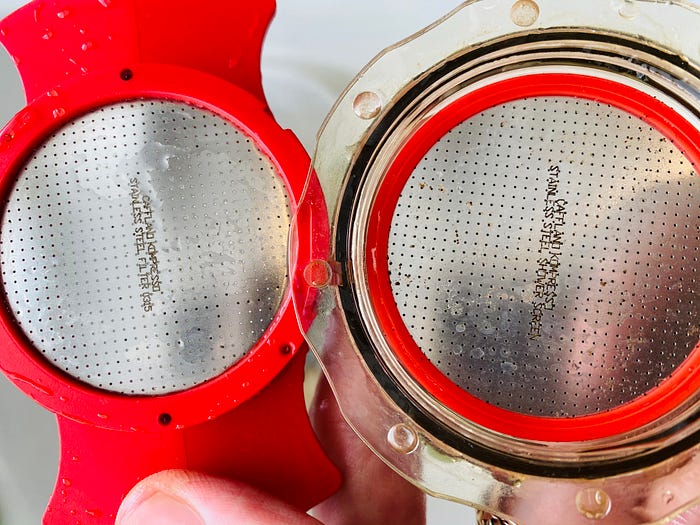An Affordable and Simple Transparent Portfilter for Espresso
Another great use of Kompresso
When I saw a transparent portafilter, I was mesmerized. I would have loved to have one to run tests and gain some deeper understanding. My own critique is that the transparent portafilter design is offset from the shower head in a way that’s not how it would be in real use. So I don’t think the shots from it are too realistic, but it would still be fun to test.
Then, I had an idea. I had previously used Kompresso to look at tamp compression because it was a clear, vertical tube, and I used the plunger as the tamper. I learned a lot about compressing coffee grounds. Why not do the same with water and then treat it like a portafilter?
Looking at the showerhead for Kompresso and the filter basket, they’re the same, so the shower head could also function as a filter basket!

This design is also not completely realistic because the puck depth is huge, but it gives the water longer to filter through so problems could potentially be viewed better.
Experiments
I started with some coffee that was spent coffee. I had dried it out and added food coloring to some of it because I ran another compression experiment where each layer was a different color. Then I just had to setup some cameras.


The main preparation issue was that the plunger (doubly as the tamper) formed a seal, so when I pulled it up, the puck would jump. I solved this by removing it very slowly, and if you put a slight angle on the plunger, it will release the seal quicker.




Pre-infusion
I started with pre-infusion, but I did have a water pour issue. I poured water directly which caused a large channel because of the speed. I later used a funnel to slow it down, and then I added a crumbled paper filter to dampen the speed. That worked really well.

Infusion saw the water move faster, but it was interesting to see the pattern of the line as the water went through. It was not so even as I would have thought it would be. It was jagged and showed this amazing flow that I had seen in some simple expresso flow models a few months ago.

Here is a couple frames where the water line goes over some clumps where the water gets slowed down in these micro-locations.

Of course pulling the plunger out at the end was tricky too.


I’m so happy to have stumbled upon this platform for testing. I have been enthralled watching the water go through the puck, the puck swell, then compress at the water is forced through. I’m particularly excited how easy it is to clean and how well it works doing a task it wasn’t designed for.
I have a nice list of things I’m interested to understand in more depth, and this platform will be a great help. I’ve already used it to verify that fines don’t migrate during the shot.
If you like, follow me on Twitter and YouTube where I post videos of espresso shots on different machines and espresso related stuff. You can also find me on LinkedIn. You can also follow me on Medium.
Further readings of mine:
Coffees by Region, Process, Grade, and Price
The Economics of Home Roasting Coffee
Deconstructed Coffee: Split Roasting, Grinding, and Layering for Better Espresso
Pre-infusion for Espresso: Visual Cues for Better Espresso
To Stir or To Swirl: Better Espresso Experience
Spicy Espresso: Grind Hot, Tamp Cold for Better Coffee
Staccato Espresso: Leveling Up Espresso
Improving Espresso with Paper Filters
Coffee Solubility in Espresso: An Initial Study
Staccato Tamping: Improving Espresso without a Sifter
Espresso Simulation: First Steps in Computer Models
